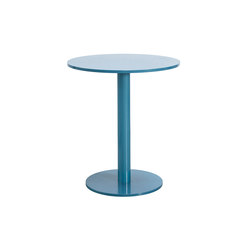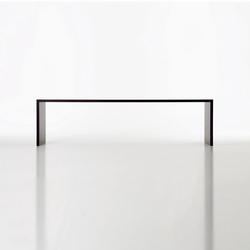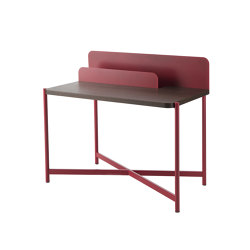Blue In Green
Side tables from Time & Style
Product description
φ450×H480
Concept
Anodization is the process used to give the final finish to aluminum to improve corrosion resistance. This process is often used for the components of computer equipment made by Apple and other companies, and for precision devices such as cameras. iPads are used in various locations where the environmental conditions are severe, so they require high levels of corrosion resistance, abrasion resistance, hardness, and electrical insulation. Aluminum anodizing is an effective way of protecting these products.
We are not a precision device manufacturer, but, since anodizing can augment corrosion resistance and strength as compared to the aluminum which is usually used, we want to make furniture using anodized dyeing and finishing of aluminum, a technique that grew out of the original process of anodizing aluminum. The anodized dyeing and finishing of aluminum means that the surface is not painted, but, just like indigo dyeing, the aluminum itself is dyed through a sealing process in which dye is poured into pores on the porous layer generated from the anodizing process, and then the pores are sealed.
This dyeing and finishing adds a touch of deepness to the aluminum and makes possible the creation of a range of colors and tones depending on the anodizing process, the density of the dye, and the duration of dye application. Aluminum anodizing is a technique designed to improve the corrosion resistance of aluminum through the following processes:
i. Electrolyze aluminum as the anode in a treatment bath containing dilute sulfuric acid or oxalic acid.
ii. The aluminum is oxidized electrochemically and a film of the oxidized aluminum is formed.
iii. The film is partially dissolved and honeycomb-like pores are created, forming a porous layer of film.
iv. The pores are sealed using boiling water or steam under pressure.
Color anodizing involves the application of color through the pores absorbing the dye utilizing the characteristics of the porous layer. Due to its ability to preserve fine colors for years and improve corrosion resistance, this technique enhances beauty and functionality.
This processing technique originated in Japan and was invented by researchers from the Institute of Physical and Chemical Research in 1929 and has been used for about 70 years. For these products, we created a design that was simple overall and adopted a simple structure by fastening solid aluminum plates for the top and bottom, and a solid aluminum pole as a prop, and assembled using joint parts and bolts. We gave the table the name “Blue in Green”.
We felt that the combination of blue and green colors was especially well suited to the anodized aluminum material. However, during the trial manufacturing, we have found that yellow, purple, and pink also go well with aluminum. Therefore, we have created products in nine colors.
“Blue in Green” is famous as a piece of music by Miles Davis, but in fact, the piece is said to be by Bill Evans, a pianist. It is a masterpiece of jazz filled with a beautiful, tasteful melody from the intro to the end.
We are not a precision device manufacturer, but, since anodizing can augment corrosion resistance and strength as compared to the aluminum which is usually used, we want to make furniture using anodized dyeing and finishing of aluminum, a technique that grew out of the original process of anodizing aluminum. The anodized dyeing and finishing of aluminum means that the surface is not painted, but, just like indigo dyeing, the aluminum itself is dyed through a sealing process in which dye is poured into pores on the porous layer generated from the anodizing process, and then the pores are sealed.
This dyeing and finishing adds a touch of deepness to the aluminum and makes possible the creation of a range of colors and tones depending on the anodizing process, the density of the dye, and the duration of dye application. Aluminum anodizing is a technique designed to improve the corrosion resistance of aluminum through the following processes:
i. Electrolyze aluminum as the anode in a treatment bath containing dilute sulfuric acid or oxalic acid.
ii. The aluminum is oxidized electrochemically and a film of the oxidized aluminum is formed.
iii. The film is partially dissolved and honeycomb-like pores are created, forming a porous layer of film.
iv. The pores are sealed using boiling water or steam under pressure.
Color anodizing involves the application of color through the pores absorbing the dye utilizing the characteristics of the porous layer. Due to its ability to preserve fine colors for years and improve corrosion resistance, this technique enhances beauty and functionality.
This processing technique originated in Japan and was invented by researchers from the Institute of Physical and Chemical Research in 1929 and has been used for about 70 years. For these products, we created a design that was simple overall and adopted a simple structure by fastening solid aluminum plates for the top and bottom, and a solid aluminum pole as a prop, and assembled using joint parts and bolts. We gave the table the name “Blue in Green”.
We felt that the combination of blue and green colors was especially well suited to the anodized aluminum material. However, during the trial manufacturing, we have found that yellow, purple, and pink also go well with aluminum. Therefore, we have created products in nine colors.
“Blue in Green” is famous as a piece of music by Miles Davis, but in fact, the piece is said to be by Bill Evans, a pianist. It is a masterpiece of jazz filled with a beautiful, tasteful melody from the intro to the end.
More about this product
Categorised in Tables - Side tables - Tabletop round - closed base - Disc base - Metal - Tabletop metal - Base metal - Residential - Contract - Hospitality.
Part of the collection
LOW TABLE / SIDE TABLE.
Manufacturer
Time & Style
Family
Blue In Green
Architonic ID
20085917
Order number
T-402
Year of Launch
2017
Similar products
Related Projects
This product has been archived. Product information may no longer be up to date.
Similar products
Where to buy this product
Where to buy this product



































